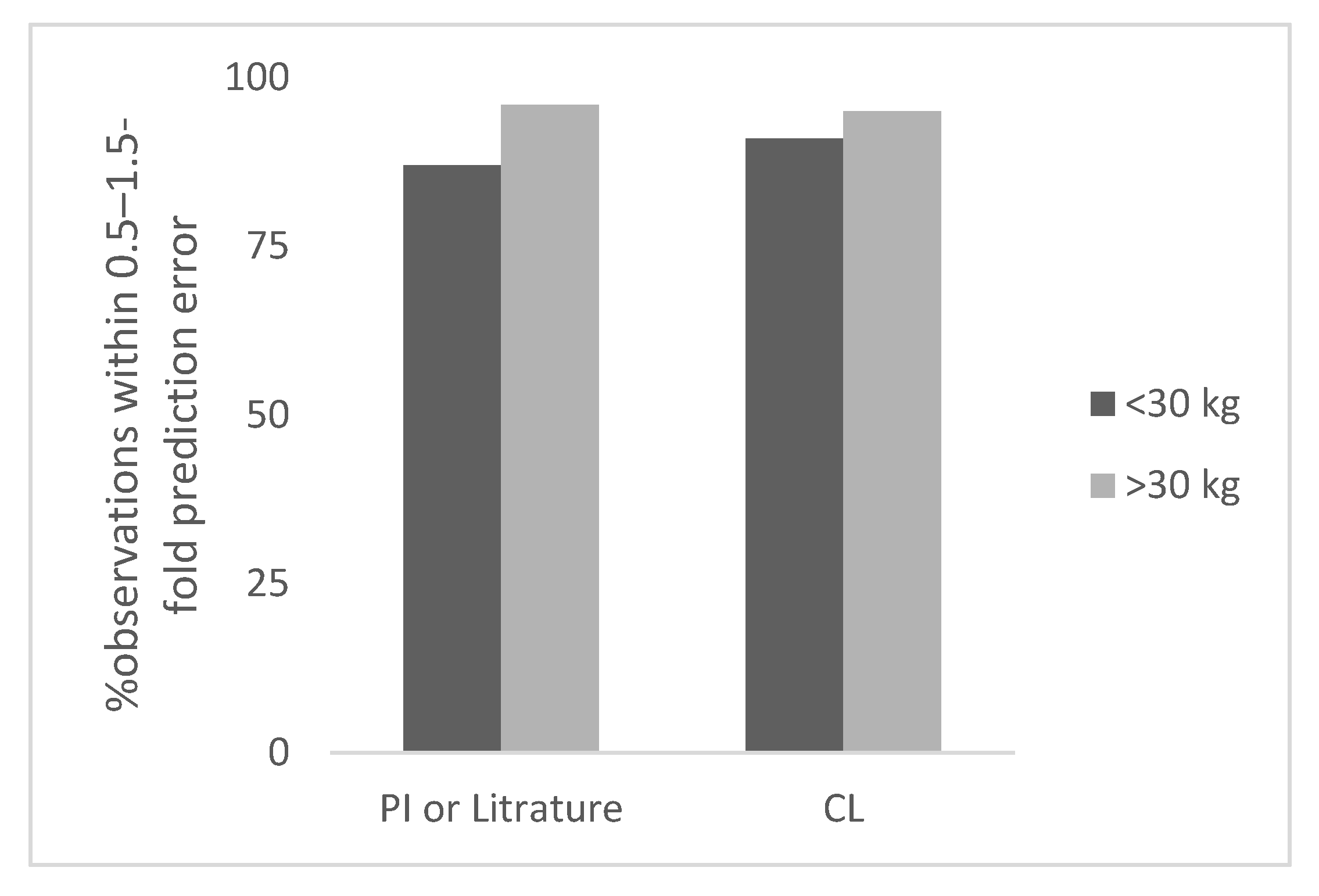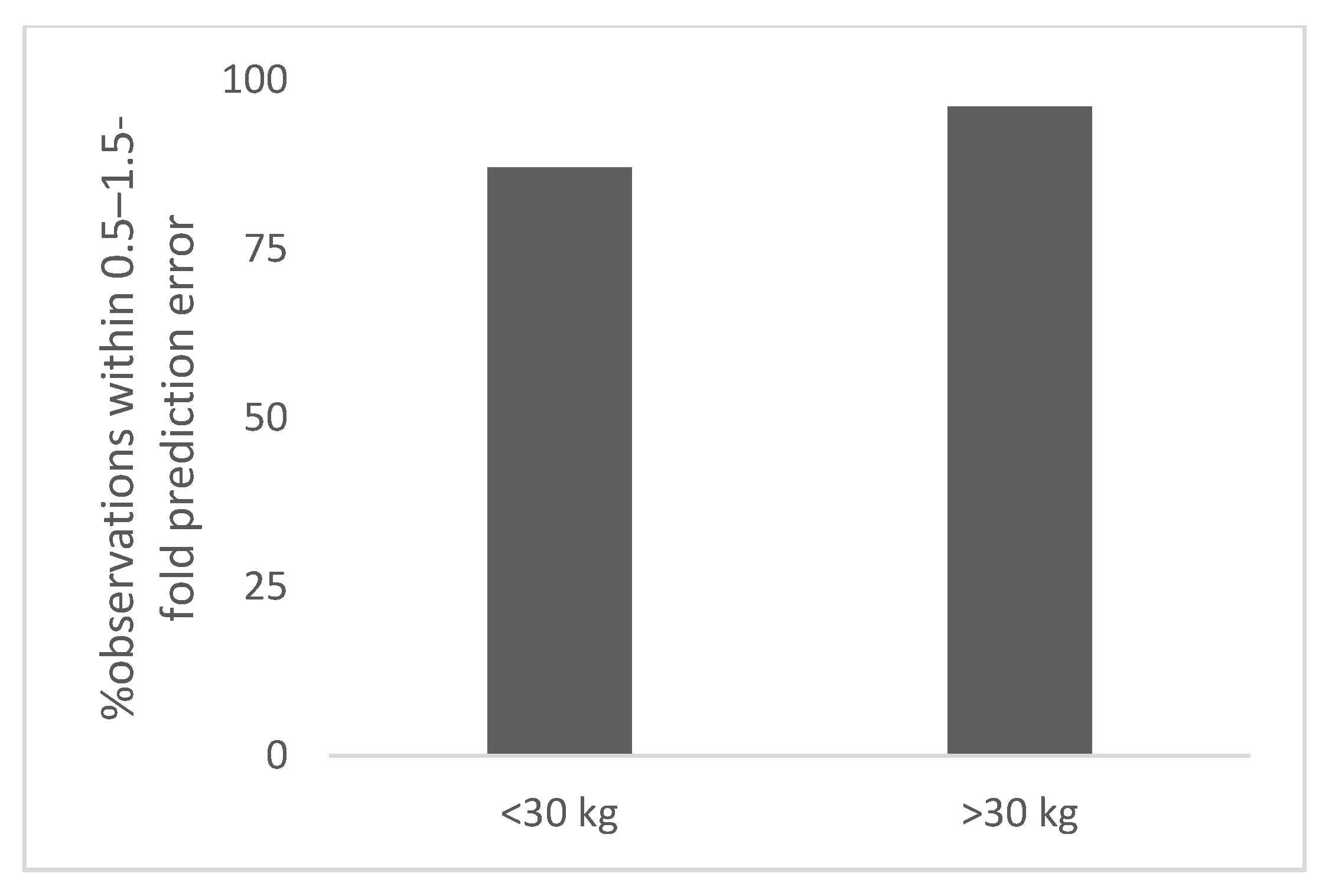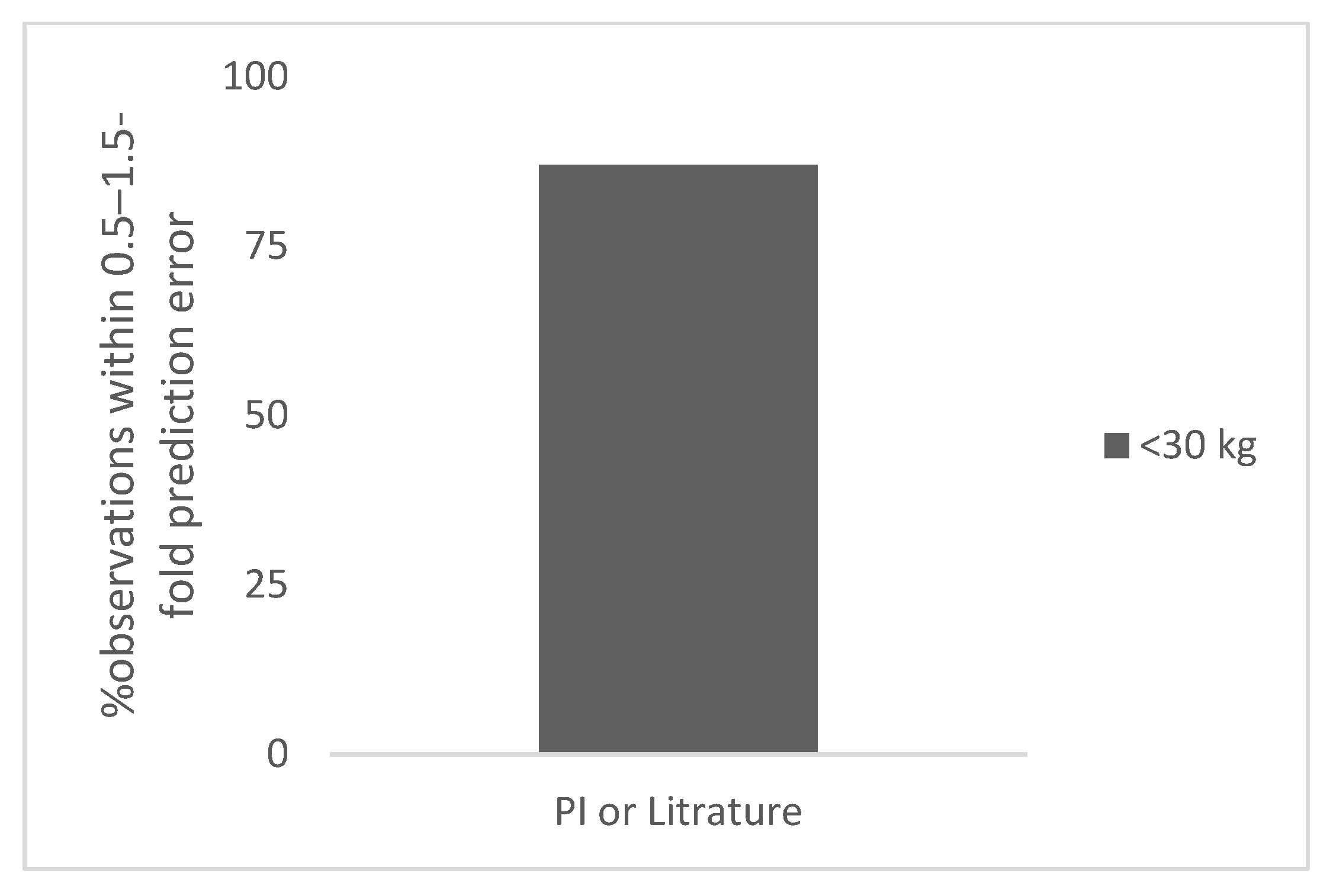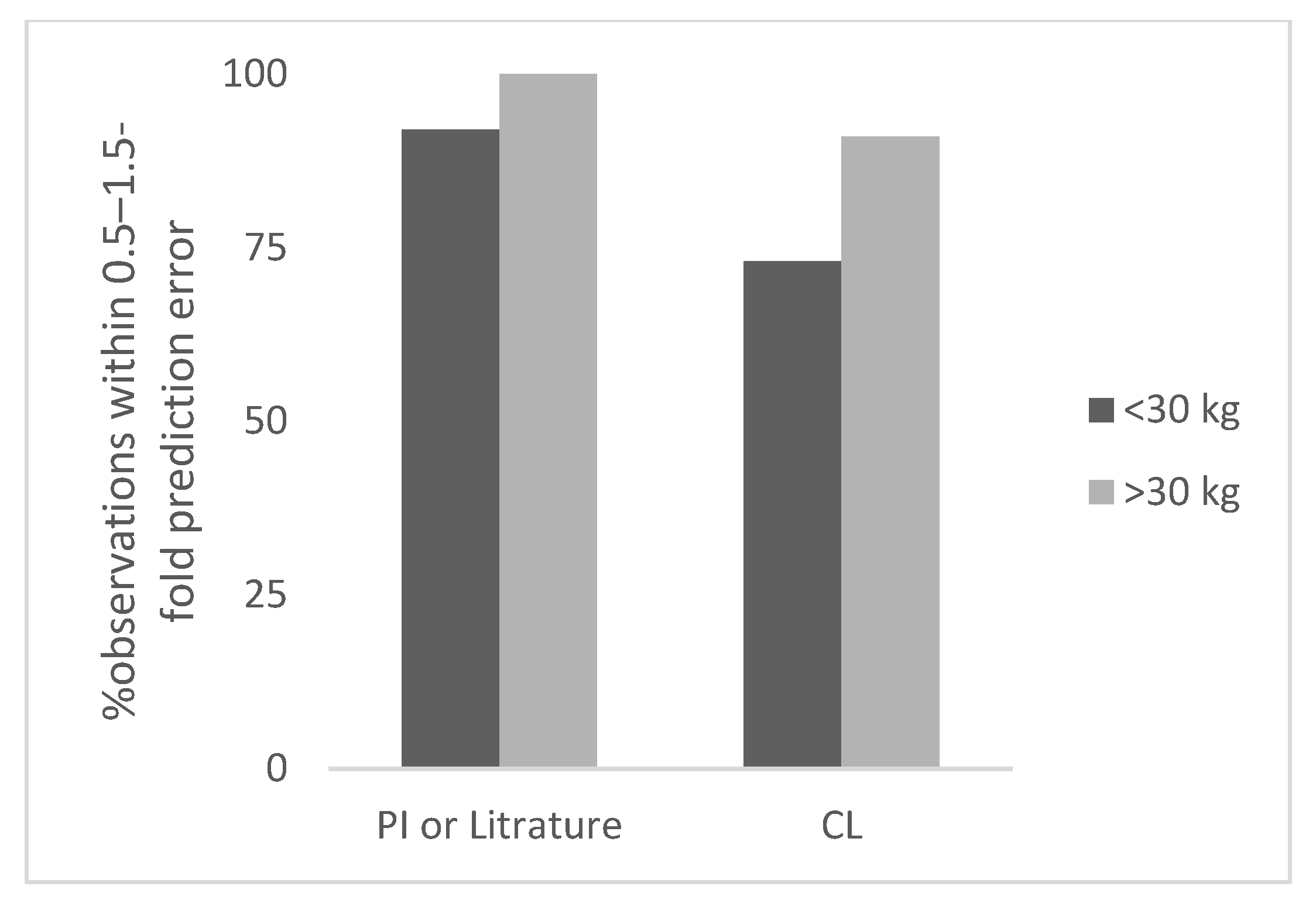A Simple Method for the Prediction of Therapeutic Proteins (Monoclonal and Polyclonal Antibodies and Non-Antibody Proteins) for First-in-Pediatric Dose Selection: Application of Salisbury Rule
Abstract
1. Introduction
2. Methods
2.1. Salisbury Rule
2.2. Statistical Analysis
3. Results
3.1. Monoclonal Antibodies
3.2. Polyclonal Antibodies (Not Premature or Term Neonates)
3.3. Polyclonal Antibodies (Premature and Term Neonates)
3.4. Therapeutic Proteins (Non-Antibodies)
4. Discussion
5. Conclusions
Supplementary Materials
Funding
Institutional Review Board Statement
Informed Consent Statement
Data Availability Statement
Conflicts of Interest
References
- Kearns, G.L.; Abdel-Rahman, S.M.; Alander, S.W.; Blowey, D.L.; Leeder, J.S.; Kauffman, R.E. Developmental pharmacology: Drug disposition, action, and therapy in infants and children. N. Engl. J. Med. 2003, 349, 1157–1167. [Google Scholar] [CrossRef] [PubMed]
- Mahmood, I. Dosing in children: A critical review of the pharmacokinetic allometric scaling and modelling approaches in paediatric drug development and clinical settings. Clin. Pharmacokinet. 2014, 53, 327–346. [Google Scholar] [CrossRef] [PubMed]
- Green, D.J.; Zineh, I.; Burckart, G.J. Pediatric Drug Development: Outlook for Science-Based Innovation. Clin. Pharmacol. Ther. 2018, 103, 376–378. [Google Scholar] [CrossRef]
- Abernethy, D.R.; Burckart, G.J. Pediatric Dose Selection. Clin. Pharmacol. Ther. 2010, 87, 270–271. [Google Scholar] [CrossRef]
- Elias, G.P.; Antoniali, C.; Mariano, R.C. Comparative study of rules employed for calculation of pediatric drug dosage. J. Appl. Oral Sci. 2005, 13, 114–119. [Google Scholar] [CrossRef]
- Mahmood, I. Dose selection in children. In Pharmacokinetic Allometric Scaling in Pediatric Drug Development; Pine House Publishers: Rockville, MD, USA, 2013; pp. 151–160. [Google Scholar]
- Lack, J.A.; Stuart-Taylor, M.E. Calculation of drug dosage and body surface area of children. Br. J. Anaesth. 1997, 78, 601–605. [Google Scholar] [CrossRef] [PubMed]
- Munzenberger, P.J.; McKercher, P. Pediatric dosing-the pharmacist’s dilemma. Contemp. Pharm. Pract. 1980, 3, 11–14. [Google Scholar]
- Kovarik, J.M.; Gridelli, B.G.; Martin, S.; Rodeck, B.; Melter, M.; Dunn, S.P.; Merion, R.M.; Tzakis, A.G.; Alonso, E.; Bucuvalas, J.; et al. Basiliximab in pediatric liver transplantation: A pharmacokinetic-derived dosing algorithm. Pediatr. Transplant. 2002, 6, 224–230. [Google Scholar] [CrossRef]
- Kovarik, J.M.; Offner, G.; Broyer, M.; Niaudet, P.; Loirat, C.; Mentser, M.; Lemire, J.; Crocker, J.F.; Cochat, P.; Clark, G.; et al. A rational dosing algorithm for basiliximab (Simulect) in pediatric renal transplantation based on pharmacokinetic-dynamic evaluations. Transplantation 2002, 74, 966–971. [Google Scholar] [CrossRef]
- Lu, J.F.; Bruno, R.; Eppler, S.; Novotny, W.; Lum, B.; Gaudreault, J. Clinical pharmacokinetics of bevacizumab in patients with solid tumors. Cancer Chemother. Pharm. 2008, 62, 779–786. [Google Scholar] [CrossRef]
- Gojo, J.; Sauermann, R.; Knaack, U.; Slavc, I.; Peyrl, A. Pharmacokinetics of Bevacizumab in Three Patients Under the Age of 3 Years with CNS Malignancies. Drugs R D 2017, 17, 469–474. [Google Scholar] [CrossRef] [PubMed]
- Temrikar, Z.H.; Suryawanshi, S.; Meibohm, B. Pharmacokinetics and Clinical Pharmacology of Monoclonal Antibodies in Pediatric Patients. Pediatr. Drugs 2020, 22, 199–216. [Google Scholar] [CrossRef]
- Burns, J.C.; Best, B.M.; Mejias, A.; Mahony, L.; Fixler, D.E.; Jafri, H.S.; Melish, M.E.; Jackson, M.A.; Asmar, B.I.; Lang, D.J.; et al. Infliximab treatment of intravenous immunoglobulin-resistant Kawasaki disease. J. Pediatr. 2008, 153, 833–838. [Google Scholar] [CrossRef] [PubMed]
- Shin, D.; Kim, Y.; Kim, Y.S.; Körnicke, T.; Fuhr, R. A Randomized, Phase I Pharmacokinetic Study Comparing SB2 and Infliximab Reference Product (Remicade) in Healthy Subjects. BioDrugs 2015, 29, 381–388. [Google Scholar] [CrossRef]
- Sun, H.; Van, L.M.; Floch, D.; Jiang, X.; Klein, U.R.; Abrams, K.; Sunkara, G. Pharmacokinetics and Pharmacodynamics of Canakinumab in Patients With Systemic Juvenile Idiopathic Arthritis. J. Clin. Pharmacol. 2016, 56, 1516–1527. [Google Scholar] [CrossRef]
- Kuemmerle-Deschner, J.B.; Ramos, E.; Blank, N.; Roesler, J.; Felix, S.D.; Jung, T.; Stricker, K.; Chakraborty, A.; Tannenbaum, S.; Wright, A.M.; et al. Canakinumab (ACZ885, a fully human IgG1 anti-IL-1β mAb) induces sustained remission in pediatric patients with cryopyrin-associated periodic syndrome (CAPS). Arthritis Res. Ther. 2011, 13, R34. [Google Scholar] [CrossRef]
- FDA. Package Insert of ILARIS (Canakinumab) for Cryopyrin-Associated Periodic Syndromes (CAPS); FDA: Silve Spring, MD, USA, 2006. [Google Scholar]
- Pescovitz, M.D.; Knechtle, S.; Alexander, S.R.; Colombani, P.; Nevins, T.; Nieforth, K.; Bouw, M.R. Safety and pharmacokinetics of daclizumab in pediatric renal transplant recipients. Pediatr. Transplant. 2008, 12, 447–455. [Google Scholar] [CrossRef]
- FDA. Package Insert of ZENAPAX (Daclizumab) for Therapy and Management of Organ Transplant Patients; FDA: Silve Spring, MD, USA, 2003. [Google Scholar]
- Autmizguine, J.; Cohen-Wolkowiez, M.; Iiowite, N. Rilonacept Pharmacokinetics in Children with Systemic Juvenile Idiopathic Arthritis. J. Clin. Pharmacol. 2015, 55, 39–44. [Google Scholar] [CrossRef]
- Trippett, T.M.; Herzog, C.; Whitlock, J.A.; Wolff, J.; Kuttesch, J.; Bagatell, R.; Hunger, S.P.; Boklan, J.; Smith, A.A.; Arceci, R.J.; et al. Phase I and pharmacokinetic study of cetuximab and irinotecan in children with refractory solid tumors: A study of the pediatric oncology experimental therapeutic investigators’ consortium. J. Clin. Oncol. 2009, 27, 5102–5208. [Google Scholar] [CrossRef] [PubMed]
- Tan, A.R.; Moore, D.F.; Hidalgo, M.; Doroshow, J.H.; Poplin, E.A.; Goodin, S.; Mauro, D.; Rubin, E.H. Pharmacokinetics of cetuximab after administration of escalating single dosing and weekly fixed dosing in patients with solid tumors. Clin. Cancer Res. 2006, 12, 6517–6522. [Google Scholar] [CrossRef]
- Hyams, J.S.; Wilson, D.C.; Thomas, A.; Heuschkel, R.; Mitton, S.; Mitchell, B.; Daniels, R.; A Libonati, M.; Zanker, S.; Kugathasan, S. Natalizumab Therapy for Moderate to Severe Crohn Disease in Adolescents. J. Pediatr. Gastroenterol. Nutr. 2007, 44, 185–191. [Google Scholar] [CrossRef] [PubMed]
- FDA. Package Insert of Natalizumab for Adults in Crohn Disease; FDA: Silve Spring, MD, USA, 2004. [Google Scholar]
- Shemesh, C.S.; Chanu, P.; Jamsen, K.; Wada, R.; Rossato, G.; Donaldson, F.; Garg, A.; Winter, H.; Ruppel, J.; Wang, X.; et al. Population pharmacokinetics, exposuresafety, and immunogenicity of atezolizumab in pediatric and young adult patients with cancer. J. Immunother. Cancer 2019, 7, 314. [Google Scholar] [CrossRef] [PubMed]
- Robbie, G.J.; Zhao, L.; Mondick, J.; Losonsky, G.; Roskos, L.K. Population Pharmacokinetics of Palivizumab, a Humanized Anti-Respiratory Syncytial Virus Monoclonal Antibody, in Adults and Children. Antimicrob. Agents Chemother. 2012, 56, 4927–4936. [Google Scholar] [CrossRef] [PubMed]
- FDA. Package Insert of Palivizumab for Children in Respiratory Syncytial Virus (RSV); FDA: Silve Spring, MD, USA, 1998. [Google Scholar]
- FDA. Package Insert of Tocilizumab for Polyarticular Juvenile Idiopathic Arthritis (PJIA); FDA: Silve Spring, MD, USA, 2010. [Google Scholar]
- Gupta, A.; Pouliquen, I.; Austin, D.; Price, R.G.; Kempsford, R.; Steinfeld, J.; Bradford, E.S.; Yancey, S.W. Subcutaneous mepolizumab in children aged 6 to 11 years with severe eosinophilic asthma. Pediatr. Pulmonol. 2019, 54, 1957–1967. [Google Scholar] [CrossRef]
- Lopez, E.L.; Contrini, M.M.; Glatstein, E.; Ayala, S.G.; Santoro, R.; Allende, D.; Ezcurra, G.; Teplitz, E.; Koyama, T.; Matsumoto, Y.; et al. Safety and Pharmacokinetics of Urtoxazumab, a Humanized Monoclonal Antibody, against Shiga-Like Toxin 2 in Healthy Adults and in Pediatric Patients Infected with Shiga-Like Toxin-Producing Escherichia coli. Antimicrob. Agents Chemother. 2010, 54, 239–243. [Google Scholar] [CrossRef]
- FDA. Package Insert of Abatacept for Polyarticular Juvenile Idiopathic Arthritis (PJIA); FDA: Silve Spring, MD, USA, 2005. [Google Scholar]
- Moudgil, A.; Dharnidharka, V.R.; Feig, D.I.; Warshaw, B.L.; Perera, V.; Murthy, B.; Roberts, M.E.; Polinsky, M.S.; Ettenger, R.B. Phase I study of single-dose pharmacokinetics and pharmacodynamics of belatacept in adolescent kidney transplant recipients. Am. J. Transplant. 2018, 19, 1218–1223. [Google Scholar] [CrossRef]
- Shen, J.; Townsend, R.; You, X.; Shen, Y.; Zhan, P.; Zhou, Z.; Geng, D.; Wu, D.; McGirr, N.; Soucek, K.; et al. Pharmacokinetics, Pharmacodynamics, and Immunogenicity of Belatacept in Adult Kidney Transplant Recipients. Clin. Drug Investig. 2013, 34, 117–126. [Google Scholar] [CrossRef]
- FDA. Package Insert of Adalimumab for Polyarticular Juvenile Idiopathic Arthritis (PJIA); FDA: Silve Spring, MD, USA, 2002. [Google Scholar]
- FDA. Package Insert of STELARA (Ustekinumab) for Moderate to Severe Plaque Psoriasis; FDA: Silve Spring, MD, USA, 2009. [Google Scholar]
- FDA. Package Insert of Raxibacumab for Inhalational Anthrax; FDA: Silve Spring, MD, USA, 2012. [Google Scholar]
- FDA. Package Insert of Obiltoxaximab for Inhalational Anthrax; FDA: Silve Spring, MD, USA, 2016. [Google Scholar]
- FDA. Package Insert of Gamaplex 10%; FDA: Silve Spring, MD, USA, 2017. [Google Scholar]
- FDA. Package Insert of GAMUNEX-C; FDA: Silve Spring, MD, USA, 2003. [Google Scholar]
- FDA. Package Insert of Cuvitru; FDA: Silve Spring, MD, USA, 2016. [Google Scholar]
- FDA. Package Insert of Pangyza; FDA: Silve Spring, MD, USA, 2018. [Google Scholar]
- FDA. Package Insert of Hizentra; FDA: Silve Spring, MD, USA, 2010. [Google Scholar]
- Noya, F.J.; Rench, M.A.; Garcia-Prats, J.A.; Jones, T.M.; Baker, C.J. Disposition of an immunoglobulin intravenous preparation in very low birth weight neonates. J. Pediatr. 1988, 112, 278–283. [Google Scholar] [CrossRef]
- Kyllonen, K.S.; Clapp, D.W.; Kliegman, R.M.; Baley, J.E.; Shenker, N.; Fanaroff, A.A.; Berger, M. Dosage of intravenously administered immune globulin and dosing interval required to maintain target levels of immunoglobulin G in low birth weight infants. J. Pediatr. 1989, 115, 1013–1016. [Google Scholar] [CrossRef]
- Weisman, L.E.; Fischer, G.W.; Marinelli, P.; Hemming, V.G.; Pierce, J.R.; Golden, S.M.; Peck, C.C. Pharmacokinetics of Intravenous Immunoglobulin in Neonates. Vox Sang. 1989, 57, 243–248. [Google Scholar] [CrossRef] [PubMed]
- Forbes, T.J.; Hijazi, Z.M.; Young, G.; Ringewald, J.M.; Aquino, P.M.; Vincent, R.N.; Qureshi, A.M.; Rome, J.J.; Rhodes, J.F.; Jones, T.K.; et al. Pediatric catheterization laboratory anticoagulation with bivalirudin. Catheter. Cardiovasc. Interv. 2011, 77, 671–679. [Google Scholar] [CrossRef] [PubMed]
- Robson, R.; White, H.; Aylward, P.; Frampton, C. Bivalirudin pharmacokinetics and pharmacodynamics: Effect of renal function, dose, and gender. Clin. Pharmacol. Ther. 2002, 71, 433–439. [Google Scholar] [CrossRef] [PubMed]
- FDA. Package Insert of ANGIOMAX (Bivalirudin) for Percutaneous Coronary Intervention; FDA: Silve Spring, MD, USA, 2000. [Google Scholar]
- Uemura, O.; Hattori, M.; Hataya, H.; Ito, S.; Ito, N.; Akizawa, T. Pharmacokinetics of darbepoetin alfa after single, intravenous or subcutaneous administration in Japanese pediatric patients with chronic kidney disease. Clin. Exp. Nephrol. 2014, 18, 932–938. [Google Scholar] [CrossRef]
- Lerner, G.; Kale, A.S.; Warady, B.A.; Jabs, K.; Bunchman, T.E.; Heatherington, A.; Olson, K.; Messer-Mann, L.; Maroni, B.J. Pharmacokinetics of darbepoetin alfa in pediatric patients with chronic kidney disease. Pediatr. Nephrol. 2002, 17, 933–937. [Google Scholar] [CrossRef] [PubMed]
- Evans, J.H.; Brocklebank, J.T.; Bowmer, C.J.; Ng, P.C. Pharmacokinetics of recombinant human erythropoietin in children with renal failure. Nephrol. Dial. Transplant. 1991, 6, 709–714. [Google Scholar] [CrossRef]
- Kindler, J.; Eckardt, K.U.; Ehmer, B.; Jandeleit, K.; Kurtz, A.; Schreiber, A.; Scigalla, P.; Sieberth, H.G. Single-dose pharmacokinetics of recombinant human erythropoietin in patients with various degrees of renal failure. Nephrol. Dial. Transpl. 1989, 4, 345–349. [Google Scholar] [CrossRef]
- Cairo, M.S.; Davenport, V.; Bessmertny, O.; Goldman, S.C.; Berg, S.L.; Kreissman, S.G.; Laver, J.; Shen, V.; Secola, R.; Van De Ven, C.; et al. Phase I/II dose escalation study of recombinant human interleukin-11 following ifosfamide, carboplatin and etoposide in children, adolescents and young adults with solid tumours or lymphoma: A clinical, haematological and biological study. Br. J. Haematol. 2005, 128, 49–58. [Google Scholar] [CrossRef]
- Barton, P.; Kalil, A.C.; Nadel, S.; Goldstein, B.; Okhuysen-Cawley, R.; Brilli, R.J.; Takano, J.S.; Martin, L.D.; Quint, P.; Yeh, T.S.; et al. Safety, pharmacokinetics, and pharmacodynamics of drotrecogin alfa (activated) in children with severe sepsis. Pediatrics 2004, 113, 7–17. [Google Scholar] [CrossRef]
- FDA. Package Insert of Drotrecogin Alfa (Activated) for Sepsis; FDA: Silve Spring, MD, USA, 2004. [Google Scholar]
- Danne, T.; Becker, R.H.A.; Heise, T.; Bittner, C.; Frick, A.D.; Rave, K. Pharmacokinetics, Prandial Glucose Control, and Safety of Insulin Glulisine in Children and Adolescents With Type 1 Diabetes. Diabetes Care 2005, 28, 2100–2105. [Google Scholar] [CrossRef]
- Rave, K.; Klein, O.; Frick, A.D.; Becker, R.H. Advantage of Premeal-Injected Insulin Glulisine Compared With Regular Human Insulin in Subjects With Type 1 Diabetes. Diabetes Care 2006, 29, 1812–1817. [Google Scholar] [CrossRef]
- Peter, F.; Savoy, C.; Ji, H.-J.; Juhasz, M.; Bidlingmaier, M.; Saenger, P. Pharmacokinetic and pharmacodynamic profile of a new sustained-release GH formulation, LB03002, in children with GH deficiency. Eur. J. Endocrinol. 2009, 160, 349–355. [Google Scholar] [CrossRef] [PubMed]
- Bidlingmaier, M.; Kim, J.; Savoy, C.; Kim, M.J.; Ebrecht, N.; de la Motte, S.; Strasburger, C.J. Comparative Pharmacokinetics and Pharmacodynamics of a New Sustained-Release Growth Hormone (GH), LB03002, Versus Daily GH in Adults with GH Deficiency. J. Clin. Endocrinol. Metab. 2006, 91, 2926–2930. [Google Scholar] [CrossRef]
- Zhang, X.; Lin, T.; Bertasso, A.; Evans, C.; Dorr, A.; Kolis, S.J.; Salgo, M.; Patel, I. Population Pharmacokinetics of Enfuvirtide in HIV-1-Infected Pediatric Patients Over 48 Weeks of Treatment. J. Clin. Pharmacol. 2007, 47, 510–517. [Google Scholar] [CrossRef] [PubMed]
- FDA. Package Insert of FUZEON (Enfuvirtide) for HIV-1 Infection; FDA: Silve Spring, MD, USA, 2003. [Google Scholar]
- Schwarz, K.B.; Mohan, P.; Narkewicz, M.R.; Molleston, J.P.; Nash, S.R.; Hu, S.; Wang, K.; Gries, J.M. Safety, Efficacy and Pharmacokinetics of Peginterferon alpha2a (40 kd) in Children with Chronic Hepatitis C. J. Pediatr. Gastroenterol. Nutr. 2006, 43, 499–505. [Google Scholar] [CrossRef]
- Mahmood, I. Prediction of Clearance of Monoclonal and Polyclonal Antibodies and Non-Antibody Proteins in Children: Application of Allometric Scaling. Antibodies 2020, 9, 40. [Google Scholar] [CrossRef] [PubMed]
- Mahmood, I. Extrapolation of Drug Clearance in Children ≤ 2 Years of Age from Empirical Models Using Data from Children (>2 Years) and Adults. Drugs R D 2020, 20, 1–10. [Google Scholar] [CrossRef] [PubMed]
- Mahmood, I.; Tegenge, M.A. A Comparative Study Between Allometric Scaling and Physiologically Based Pharmacokinetic Modeling for the Prediction of Drug Clearance From Neonates to Adolescents. J. Clin. Pharmacol. 2019, 59, 189–197. [Google Scholar] [CrossRef]
- Mahmood, I. Prediction of clearance, volume of distribution, and half-life of drugs in extremely low to low birth weight neonates: An allometric approach. Eur. J. Drug Metab. Pharmacokinet. 2017, 42, 601–610. [Google Scholar] [CrossRef] [PubMed]
- Deyme, L.; Benzekry, S.; Ciccolini, J. Mechanistic models for hematological toxicities: Small is beautiful. CPT Pharmacometrics Syst. Pharmacol. 2021, 10, 396–398. [Google Scholar] [CrossRef]
- Box, G.E.P. Science and statistics. J. Am. Stat. Assoc. 1976, 71, 791–799. [Google Scholar] [CrossRef]




| Error | Based on FDA Package Insert or Literature | Based on CL | ||
|---|---|---|---|---|
| Monoclonal (n = 21) | <30 kg (n = 31) | ≥30 kg (n = 28) | <30 kg (n = 21) | ≥30 kg (n = 21) |
| 0.5–1.5-fold | 27 (87.1) | 27 (96.4%) | 19 (90.5%) | 20 (95.2%) |
| ≤30% (≥0.7–≤1.3) | 11 (35.5%) | 25 (89.3%) | 14 (66.7%) | 18 (85.7%) |
| ≥130% (>1.3-fold) | 17 (54.8%) | 2 (7.1%) | 5 (23.8%) | 3 (14.3%) |
| ≤70% (≤0.7-fold) | 3 (9.7%) | 1 (3.6%) | 2 (9.5%) | 0 (0.0%) |
| Polyclonal (n = 5) | <30 kg (n = 9) | ≥30 kg (n = 5) | ||
| 0.5–1.5-fold | 9 (100%) | 5 (100%) | NA | NA |
| ≤30% (≥0.7–≤1.3) | 0 (0%) | 5 (100%) | NA | NA |
| ≥130% (>1.3-fold) | 9 (100%) | 0 (0%) | NA | NA |
| ≤70% (≤0.7-fold) | 0 (0%) | 0 (0%) | NA | NA |
| Polyclonal (premature) (n = 4 polyclonal antibodies) n = 9 observations, body weight range = 1–3 kg | ||||
| 0.5–1.5-fold | 8 (89%) | NA | NA | NA |
| ≤30% (≥0.7–≤1.3) | 6 (67%) | NA | NA | NA |
| ≥130% (>1.3-fold) | 1 (11%) | NA | NA | NA |
| ≤70% (≤0.7-fold) | 2 (22%) | NA | NA | NA |
| Proteins (non-antibodies) n = 11 | <30 kg (n = 12) | ≥30 kg (n = 11) | <30 kg (n = 11) | ≥30 kg (n = 11) |
| 0.5–1.5-fold | 11 (91.7%) | 11 (100%) | 8 (72.7%) | 10 (90.9%) |
| ≤30% (≥0.7–≤1.3) | 5 (41.7%) | 9 (81.8%) | 7 (63.6%) | 9 (81.8%) |
| ≥130% (>1.3-fold) | 5 (41.7%) | 1 (9.1%) | 3 (27.3%) | 2 (18.2%) |
| ≤70% (≤0.7-fold) | 1 (5%) | 1 (9.1%) | 2 (18.2) | 0 (0%) |
Publisher’s Note: MDPI stays neutral with regard to jurisdictional claims in published maps and institutional affiliations. |
© 2022 by the author. Licensee MDPI, Basel, Switzerland. This article is an open access article distributed under the terms and conditions of the Creative Commons Attribution (CC BY) license (https://creativecommons.org/licenses/by/4.0/).
Share and Cite
Mahmood, I. A Simple Method for the Prediction of Therapeutic Proteins (Monoclonal and Polyclonal Antibodies and Non-Antibody Proteins) for First-in-Pediatric Dose Selection: Application of Salisbury Rule. Antibodies 2022, 11, 66. https://doi.org/10.3390/antib11040066
Mahmood I. A Simple Method for the Prediction of Therapeutic Proteins (Monoclonal and Polyclonal Antibodies and Non-Antibody Proteins) for First-in-Pediatric Dose Selection: Application of Salisbury Rule. Antibodies. 2022; 11(4):66. https://doi.org/10.3390/antib11040066
Chicago/Turabian StyleMahmood, Iftekhar. 2022. "A Simple Method for the Prediction of Therapeutic Proteins (Monoclonal and Polyclonal Antibodies and Non-Antibody Proteins) for First-in-Pediatric Dose Selection: Application of Salisbury Rule" Antibodies 11, no. 4: 66. https://doi.org/10.3390/antib11040066
APA StyleMahmood, I. (2022). A Simple Method for the Prediction of Therapeutic Proteins (Monoclonal and Polyclonal Antibodies and Non-Antibody Proteins) for First-in-Pediatric Dose Selection: Application of Salisbury Rule. Antibodies, 11(4), 66. https://doi.org/10.3390/antib11040066





